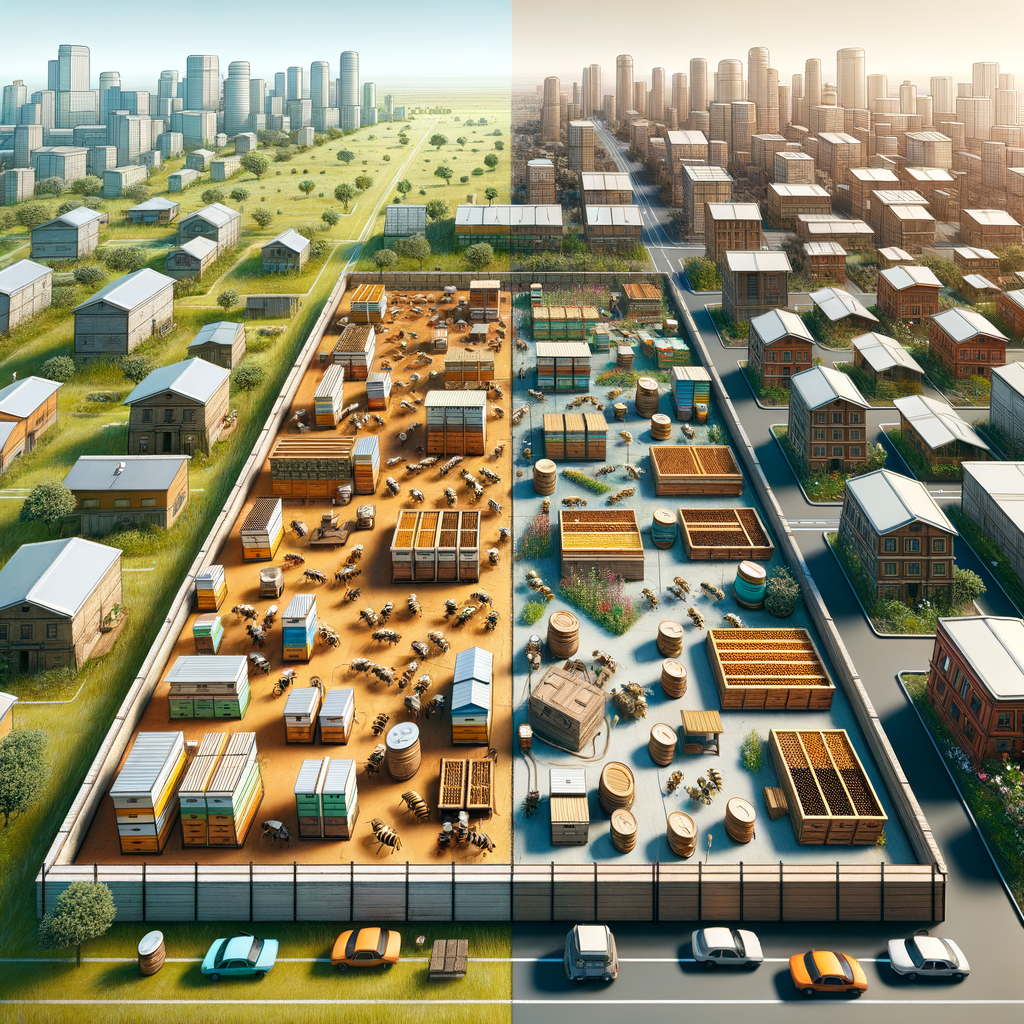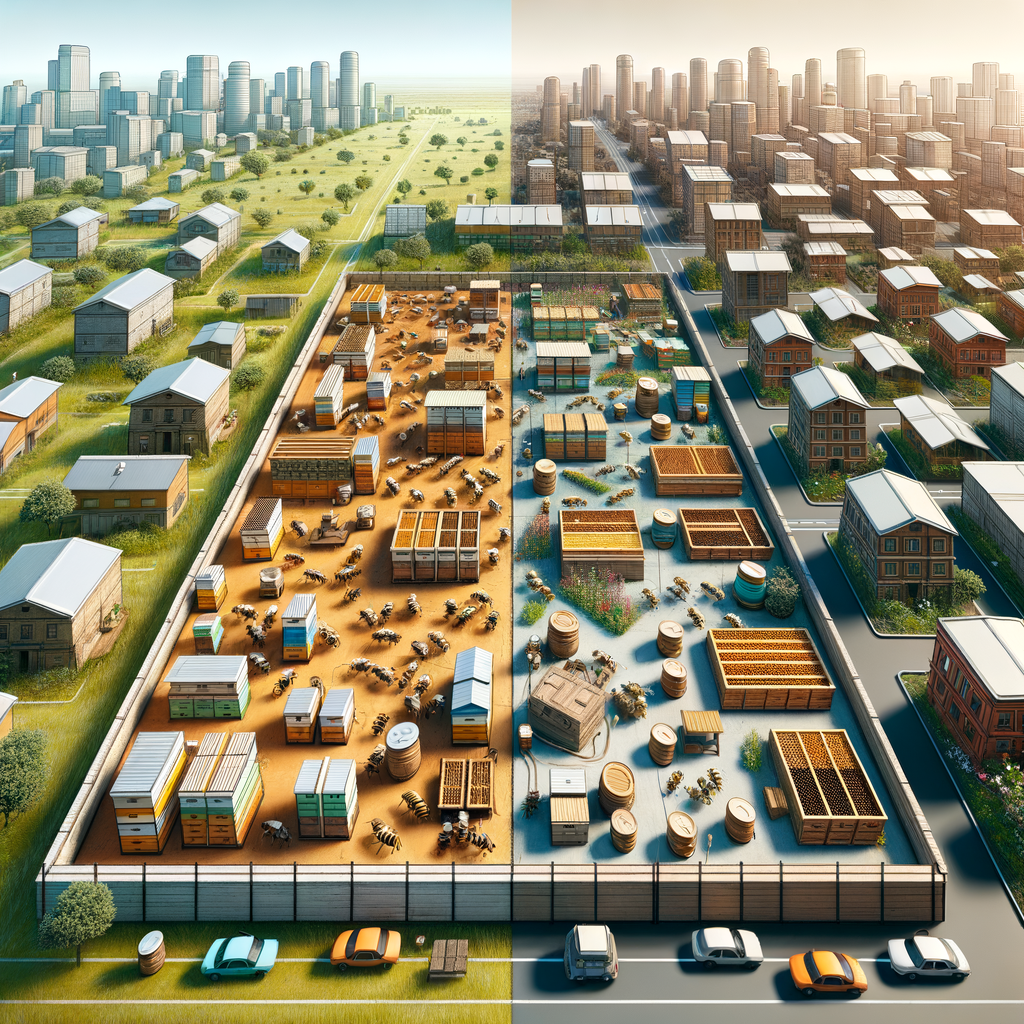
Introduction to Beekeeping Space Needs
When it comes to beekeeping, one of the most important aspects to consider is space. Bees are not just any ordinary insects; they require a specific environment to thrive and produce honey. Understanding the space needs of bees is crucial for successful beekeeping. In this section, we will delve into the importance of space in beekeeping and the factors that influence these space needs.
- Understanding the Importance of Space in Beekeeping
Space plays a significant role in beekeeping. It is not just about having a place to put your beehive; it’s about providing an environment where bees can thrive and produce honey. Bees need space to build their honeycomb, store honey, and raise their young. If bees don’t have enough space, they may become overcrowded, leading to problems like swarming, where a large group of bees leaves the hive to find a new home. This can greatly reduce your honey production and may even lead to the collapse of your bee colony.
- Factors Influencing the Space Needs for Beekeeping
Several factors determine the space needs for beekeeping. These include:
| Factor | Description |
|---|---|
| Size of the Bee Colony | The size of your bee colony is a major factor. Larger colonies require more space than smaller ones. |
| Location and Climate | The location and climate of your beekeeping area can influence space needs. For example, bees in colder climates need more space to store honey for the winter. |
| Type of Bees | Different types of bees have different space needs. For instance, Italian bees are known to build larger colonies than Carniolan bees. |
Understanding these factors can help you provide the right amount of space for your bees, leading to a healthier and more productive bee colony.
Beehive Placement and Space Management
Understanding the importance of beehive placement and effective space management is crucial for successful beekeeping. Let’s delve into the details.
Optimal Beehive Placement
- Choosing the right location for your beehive: The location of your beehive can greatly impact the health and productivity of your bees. Choose a location that is easily accessible, has good sun exposure, and is protected from harsh weather conditions.
- Importance of sun exposure and wind direction: Bees thrive in sunny locations. A hive placed in the sun is less likely to have issues with pests. Also, consider the wind direction when placing your hive. A hive entrance facing away from prevailing winds helps protect the bees.
- Maximizing space efficiency in your beekeeping area: Efficient use of space can help you manage multiple hives effectively. Ensure there is enough space between hives for bees to fly in and out without disturbing neighboring hives.
- Organizing your beekeeping setup for easy access and maintenance: Arrange your hives in a way that allows easy access for maintenance and honey collection. This will make your beekeeping tasks easier and more efficient.
- Understanding the minimum space for backyard beekeeping: A single hive needs about 10 square feet of space. However, you’ll need additional space for movement and maintenance tasks. Plan your space accordingly.
- Case study: Successful backyard beekeeping setups: Many backyard beekeepers have found success with a small number of hives. For example, a beekeeper in Oregon successfully manages three hives in a 30 square foot area, proving that effective space management can lead to successful beekeeping even in small spaces.
- Challenges and solutions for urban beekeeping: Urban beekeeping presents unique challenges, such as limited space and proximity to neighbors. However, with careful planning and community engagement, urban beekeeping can be successful. Rooftop beekeeping is one innovative solution to the space challenge in urban areas.
- Case study: Innovative urban beekeeping spaces: In New York City, beekeepers have turned rooftops into thriving beekeeping spaces. This innovative use of space has allowed urban beekeeping to flourish in a city with limited green spaces.
- Essential beekeeping equipment and their space requirements: Apart from the hives, you’ll need space for beekeeping equipment like smokers, hive tools, and honey extractors. Consider these when planning your beekeeping space.
- Organizing your beekeeping equipment for optimal space usage: Keep your beekeeping tools organized. This not only saves space but also makes your tasks easier and more efficient.
- How to effectively manage your beekeeping space: Regular maintenance, efficient arrangement of hives, and good organization of tools are key to effective space management in beekeeping.
- Top tips for maximizing your beekeeping area: Use vertical space where possible, keep your area clean and organized, and always plan for growth. These tips can help you make the most of your beekeeping area.
- Recap of key takeaways on beekeeping space needs: Choosing the right location, maximizing space efficiency, and organizing your setup effectively are crucial for successful beekeeping.
- Final thoughts on the role of space in successful beekeeping: Space management plays a vital role in beekeeping. With careful planning and effective management, even a small space can become a successful beekeeping area.








